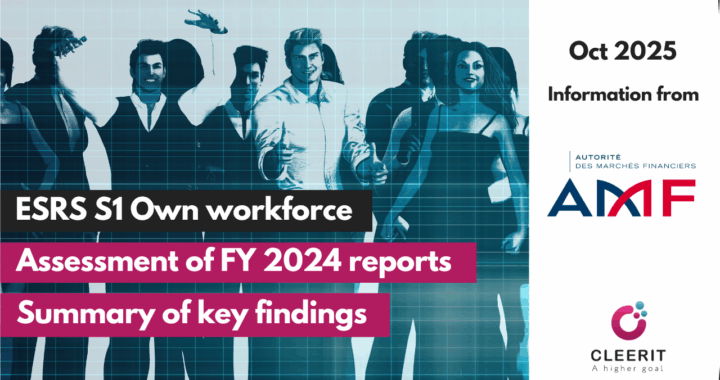AMF, the French Financial Markets Authority assessed a sample of ESRS statements published by French listed companies under the CSRD for financial year 2024.
This report is very valuable as it gives you information on what the financial marketplace is expecting from your sustainability reports. We will send you the information regrouped by subject. Below you will a summary of the key findings related to ESRS S1 Own workforce.
We strongly recommend that you use the IRO E/S/G plans in Cleerit to structure your information on IROs, policies, actions and targets, before including these tables into the datapoints in the ESRS templates. This will ensure that you structure the information as expected by the financial market. Don’t hesitate to contact us if you need further guidance on this point.
The AMF (Autorité des Marchés Financiers) regulates the French financial marketplace, its participants and the investment products distributed via the markets. It also ensures that investors are properly informed and is a driving force behind regulatory change at both European and international levels. As an independent public authority, it has regulatory powers and a substantial level of financial and managerial independence. To carry out their tasks, AMF is required to regulate, authorize, monitor and where necessary, inspect, investigate and enforce.
Overall comments on ESRS S1 Own workforce first-wave disclosures (FY 2024)
For social-related topics specific information on the DMA process is provided only in very rare cases, and information on input parameters (sources/assumptions) is often not specified.
Policies, actions and targets (PAT) disclosures are overly narrative and often lack the structure and precision needed for usability and comparability. This narrative-heavy approach results in lengthy but low-informational disclosures.
While some companies articulate the alignment clearly between PATs, and their explicit linkage to the material impacts, risks, and opportunities (IROs) identified during DMA, most disclosures remain siloed, preventing readers from understanding how corporate responses are tailored to material sustainability topics.
Many companies rely on general wording, high-level ambitions, or reaffirmations of principles (e.g. alignment with international frameworks or « commitment to diversity »), without operational details.
Good practices:
- Embedding the IRO-to-response logic systematically across S1 disclosures would enhance narrative coherence, reduce duplication, and reinforce alignment with the ESRS architecture.
- Using tables to summarize the expected outcomes, time horizons and progress of actions, provides clearer insight into how impacts are managed.
PATs – policies, actions and targets
Human rights and DEI policies are disclosed almost systematically, but often in very boilerplate terms, without explaining how international frameworks are translated into internal processes.
DEI-related disclosures sometimes omit a breakdown of the types of discrimination addressed.
Not all concretely explain how the effectiveness of policies is monitored (internal audit mechanisms, examples of corrective actions taken in response to policy breaches…), and only a small number explain how the effectiveness of actions is assessed over time.
Very few provide information on the financial or operational resources allocated to actions.
Companies still structuring their sustainability governance and processes likely lack the tools or processes to track and disclose the associated resources deployed, even for topics deemed material.
The quality and usefulness of targets vary widely. Only a few are precise and time-bound, while others are broad qualitative aspirations.
Only a minority report on progress year-over-year, or even indicate a reference value preventing stakeholders from assessing the effectiveness of the actions deployed.
Very few companies disclose changes to targets or metrics over time, thereby missing the opportunity to explain strategic reorientations or learning processes.
Nearly none of the companies provide evidence of engagement with workers or relevant stakeholders in the design or monitoring of targets, which calls into question the degree to which the targets reflect operational priorities or workforce realities. Where engagement is mentioned, it remains high-level and provides little information about the actual performance management process.
When companies do not set targets, they either don’t indicate it or mention the absence of a target without explaining the underlying reasons (e.g. lack of data, etc.).
Gender and age breakdown metrics are valued by investors, but the prevailing disclosure approach remains largely descriptive and non-analytical, often limited to high-level figures without commentary or interpretation.
Very few companies provide a breakdown by job function, a level of detail that helps identify potential imbalances – such as age concentration in lower-level positions or lack of age diversity in management roles.
In most cases, disclosures do not discuss how age diversity is monitored or linked to workforce planning or inclusion goals. This suggests a low level of maturity in how companies use this metric as a tool for organizational development.
Source: https://www.amf-france.org/sites/institutionnel/files/private/2025-10/amf_study_csrd_reporting_the_way_forward_2025.pdf
By using Cleerit ESG to structure your S1 disclosures on IROs and PATs you will increase both ESRS compliance and organizational efficiency. Contact us if you are interested in learning more >>>.
